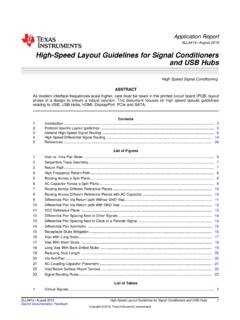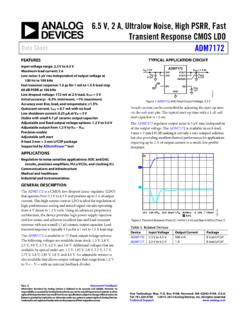Transcription of HDMI Design Guide 2
1 TI HDMI Design Guide June 2007 High-Speed Interface Products 1 HDMI Design Guide TI HDMI Design Guide June 2007 High-Speed Interface Products 2 Introduction This application note presents Design Guide lines helping users of the HDMI 3:1 mux-repeater, TMDS341A, to utilize the full performance of the device through careful printed circuit board (PCB) Design . The paper provides recommendations for-, and explains important concepts of some main aspects of high-speed PCB Design .
2 These subjects, presented in the following order, are: layer stack, differential traces, controlled impedance transmission lines, discontinuities, routing guidelines, reference planes, vias and decoupling capacitors. Layer stack The pin-out of the TMDS341A is tailored for the Design in HDMI receiver circuits. Each side of the package provides a HDMI port, featuring four differential TMDS signal pairs, thus resulting in three input- and one output port. The remaining signals comprise the supply rails, Vcc and ground, and lower speed signals such as the I2C interface, Hotplug-detect and the mux-selector pins. HDMI 1 HDMI 2 HDMI 3 HDMI OUTTMDS341 ATMDS-signalsVccGNDI2C & CTRL signals Fig.
3 1. The TMDS341A pin-out is tailored for HDMI receiver applications A minimum of four layers are required to accomplish a low EMI PCB Design . Layer stacking should be in the following order, (top-to-bottom): TMDS signal layer, ground plane, power plane and control signal layer. Layer 1:Layer 2:Layer 3:Layer 4:High-speed, differential (TMDS) signal tracesGround planePower planeLow-frequency,single-ended tracesLayer 1:Layer 2:Layer 5:Layer 6:High-speed, differentialsignal tracesGroundVcc2 Low-frequency,single-ended tracesLayer 4:GroundLayer 3: Vcc15 - 10 mils20 - 40 mils5 - 10 mils Fig. 2. Recommended 4- or 6- layer stack for a receiver PCB Design Routing the high-speed TMDS traces on the top layer avoids the use of vias (and the introduction of their inductances) and allows for clean interconnects from the HDMI connectors to the repeater inputs and from the repeater output to the subsequent receiver circuit.
4 TI HDMI Design Guide June 2007 High-Speed Interface Products 3 Placing a solid ground plane next to the high-speed signal layer establishes controlled impedance for transmission line interconnects and provides an excellent low-inductance path for the return current flow. Placing the power plane next to the ground plane creates additional high-frequency bypass capacitance. Routing the slower speed control signals on the bottom layer allows for greater flexibility as these signal links usually have margin to tolerate discontinuities such as vias.
5 If an additional supply voltage plane or signal layer is needed, add a second power / ground plane system to the stack to keep it symmetrical. This makes the stack mechanically stable and prevents it from warping. Also the power and ground plane of each power system can be placed closer together, thus increasing the high-frequency bypass capacitance significantly. differential Traces HDMI uses transition minimized differential signaling (TMDS) for transmitting high-speed serial data. differential signaling offers significant benefits over single-ended signaling. In single-ended systems current flows from the source to the load through one conductor and returns via a ground plane or wire.
6 The transversal electromagnetic wave (TEM), created by the current flow, can freely radiate to the outside environment causing severe electromagnetic interference (EMI). Also noise from external sources induced into the conductor is unavoidably amplified by the receiver, thus compromising signal integrity. differential signaling instead uses two conductors, one for the forward-, the other one for the return current to flow. Thus, when closely coupled, the currents in the two conductors are of equal amplitude but opposite polarity and their magnetic fields cancel. The TEM waves of the two conductors, now being robbed of their magnetic fields, cannot radiate into the environment.
7 Only the far smaller fringing fields outside the conductor loop can radiate, thus yielding significantly lower EMI. FringingfieldsFringingfieldsHEtFringingf ieldsCoupledfields Fig. 3. TEM wave radiation from the large fringing fields around a single conductor and the small fringing fields outside the closely coupled conductor loop of a differential signal pair Another benefit of close electric coupling is that external noise induced into both conductors equally appears as common-mode noise at the receiver input. Receivers with differential inputs are sensitive to signal differences only, but immune to common-mode signals. The receiver therefore rejects common-mode noise and signal integrity is maintained.
8 To make differential signaling work on a PCB, the spacing of the two traces of a differential signal pair must be kept the same across the entire length of the trace. Otherwise variations in the spacing will cause imbalances in the field coupling, therefore reducing the cancellation of the magnetic fields and leading to increased EMI. In addition to larger EMI, changes in conductor spacing cause the differential impedance of the signal pair to change, thus creating discontinuities in an impedance - controlled transmission system which leads to signal reflections compromising signal integrity. Besides consistent spacing, both conductors must be of equal electrical length to ensure their signals reach the receiver inputs at the same time.
9 Figure 4 shows the + and the - signals of a differential pair during logic state changes for traces of equal and different length. TI HDMI Design Guide June 2007 High-Speed Interface Products 4 + signal- signalnoise-pulses duringlogic state changes+ signal- signalpreviousswitchingpointlogic state changes Fig. 4. Traces of different electrical length cause phase shifts between signal, generating difference signals that cause serious EMI problems For traces of equal length both signals are equal and opposite. Their sum must therefore add to zero.
10 If the traces differ in electrical length, the signal on the shorter trace changes its state earlier than the one on the longer trace. During that time both traces drive currents into the same direction. Because the longer trace, which is supposed to act as return path, continues to drive current, the current of the early driving, shorter trace must find its return path via a reference plane (power or ground). When adding both signals the sum signal diverts from the zero level during the transition phase. At high frequency these difference signals appear as sharp transients of considerable magnitude, showing up on the ground plane, causing serious EMI problems.










